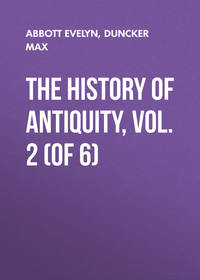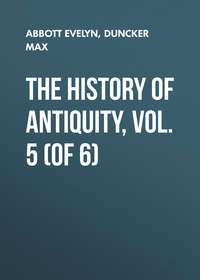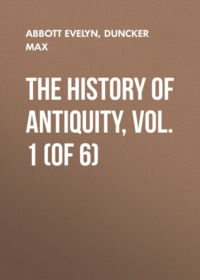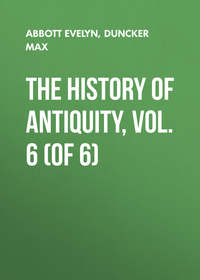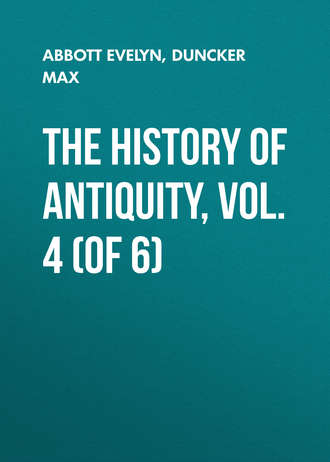 полная версия
полная версияThe History of Antiquity, Vol. 4 (of 6)
28
Megasthenes and Eratosthenes in Strabo, pp. 689, 690; Arrian, "Ind." 3, 8.
29
Lassen explains Paropamisus as Paropa-nishadha, "lower mountain," in opposition to Nishadha, "high mountain," by which the high ridge of the Hindu Kush is meant, loc. cit. 12, 27, n. 4.
30
Muir, "Sanskrit Texts," 22, 324, 328.
31
Strabo, pp. 690, 691.
32
Diod. 2, 35; Strabo, pp. 700, 717.
33
Megasthenes in Strabo, pp. 690, 702; cf. Arrian, "Ind." 4. Diodorus allows the upper Ganges a breadth of 30 stades, at Palibothra a breadth of 32 stades – 2, 37; 17, 93.
34
Arrian, "Ind." 4.
35
Diod. 2, 37.
36
Strabo, p. 691.
37
Diod. 2, 37.
38
Strabo, p. 695.
39
Diod. 2, 37.
40
Strabo, pp. 690, 691.
41
Aristobulus in Strabo, pp. 692, 693; cf. Curtius, 8, 30, ed. Mützell.
42
These statements, which are quite correct, are found in Megasthenes in Strabo, p. 76; Diod. 2, 35.
43
Strabo, p. 695; Diod. 2, 35.
44
Strabo, pp. 690, 693.
45
Strabo, p. 695.
46
Strabo, p. 694; Arrian, "Ind." 11.
47
Strabo, pp. 692, 693. Arrian ("Ind." 7) mentions the Sanskrit name of the umbrella palm, tala, and tells us that the shoots were eaten, which is also correct.
48
Arrian, "Ind." 6, 17; Strabo, pp. 96, 690, 696, 701, 706, 709.
49
Max Müller, "Hist. of Sanskrit Liter." p. 481 ff. Kaegi, "Rigveda," 1, 9 ff.
50
Roth, "Literatur des Veda," s. 120.
51
In the later hymns of the Rigveda, Angiras and Bhrigu are combined with other sages and minstrels of old time into a septad of saints (10, 109, 4), and designated the great saints. They are, beside Bhrigu and Angiras, Viçvamitra, Vasishtha, Kaçyapa, Atri, Agastya. The eight saints from whom the eight tribes of the Brahman priests now in existence are derived are: Jamadagni, Gautama, Bharadvaja, Viçvamitra, Vasishtha, Kaçyapa, Atri, Agastya. Jamadagni is said to have sprung from Bhrigu; Gautama and Bharadvaja from Angiras.
52
Muir, "Sanskrit texts," 3, 117 ff.; 121 ff.
53
A. Weber, "Ind. Studien," 1. 88.
54
Muir, "Sanskrit texts," 12, 160 ff.
55
Kuhn in Weber, "Ind. Stud." 1. 202. The Çatapatha-Brahmana (Weber, "Ind. Stud." 1. 161) tells us that Manu, when washing his hands in the morning, took a fish in his hands, which said to him – "Spare me, and I will save thee; a flood will wash away all creatures." The fish grew to a monstrous size, and Manu brought him to the ocean; and it bid Manu build a ship, and embark on the ocean. When the flood rose, the fish swam beside the ship, and Manu attached it by a rope to the horn of the fish. Thus the ship passed over the northern mountains. And the fish told Manu that he had saved him, and bade him fasten the ship to a tree. So Manu went up as the waters sank from the northern hills. The flood carried away all creatures; Manu alone remained. Eager for posterity, Manu offered sacrifice, and threw clarified butter, curdled milk, and whey into the water. After a year a woman rose out of the water, with clarified butter under her feet. Mitra and Varuna asked her whether she was their daughter, but she replied that she was the daughter of Manu, who had begotten her, and she went to Manu and told him that he had begotten her by the sacrifice which he had thrown into the water. He was to conduct her to the sacrifice, and he would then receive posterity and herds. And Manu did so, and lived with her with sacrifice and strict meditation, and through her began the posterity of Manu. Cf. M. Müller, "Hist. of Sanskrit Liter." p. 425 ff. The later form of the Indian legend of the flood is found in an episode of the Maha-bharata. Here the fish appears to Manu when he is performing some expiatory rites on the shore of a river. The fish grew so mighty that Manu was compelled to bring it into the Ganges, and when it became too large for this into the ocean. When swimming in the ocean the fish announced the flood, and bade Manu and the seven saints (Rishis) ascend the ship, and take with them all kinds of seeds. Then the fish drew the ship attached to his horn through the ocean, and there was no more land to be seen; for several years all was water and sky. At last the fish drew the ship to the highest part of the Himavat, and with a smile bade the rishis bind the ship to this, which to this day bears the name of Naubandhana (ship-binding). Then the fish revealed himself to the seven saints as Brahman, and commanded Manu to create all living creatures, gods, Asuras, and men, and all things movable and immovable; which command Manu performed. The legend overlooks the fact that the new creation was unnecessary, as we have already been told that Manu brought seeds of everything on board ship. The poems of the Rigveda present no trace of the legend of the flood. It may have arisen in the land of the Ganges, from the experience of the floods there, unless it is simply borrowed from external sources. In any case it is of later date; the Çatapatha-Brahmana is one of the later Brahmanas. Weber, "Ind. Stud." 9, 423; Kuhn, "Beiträge," 4, 288. I cannot follow De Gubernatis, "Letture," p. 228, ff, seqq.
56
Kaegi, "Rigveda," 2, 58.
57
On the Bhrigus see A. Weber, "Z. D. M. G." 9, 240. Kuhn, "Herabkunft," s. 21 ff.
58
On the Sarayu, which is mentioned, "Rigveda," 4, 30, 14, and 10, 64, 9, cf. Lassen, loc. cit. 12, 644.
59
"Rigveda," 1, 126, 1; 8, 21, 18.
60
Muir, loc. cit. 5, 451, 456.
61
"Rigveda," 7, 18, 2; in Muir, loc. cit. 5, 455.
62
"Rigveda," 1, 28, 5; 6, 47, 29.
63
"Rigveda." 6, 75, in Muir, loc. cit. 5, 469, 471.
64
Roth, "Das lied des Arztes," "Rigveda," 10, 97. "Z. D. M. G." 1871, 645.
65
Muir, loc. cit. 5, 457, 461, 465.
66
Muir, loc. cit. 5, 463.
67
"Rigveda," 10, 21, 5. Above, p. 29.
68
"Rigveda," 1, 94, 7; 1, 140, 1.
69
"Samaveda," by Benfey, 2, 7, 2, 1.
70
"Samaveda," by Benfey, 1, 1, 2, 2; 1, 1, 1, 9.
71
Muir, loc. cit. 5, 212 ff.
72
Kuhn, "Herabkunft des Feuers," s. 23 ff., 36 ff., 70 ff.
73
Kaegi, "Rigveda," 1, 23.
74
The triple birth is explained differently in the poems of the Rigveda and in the Brahmanas.
75
"Rigveda," 1, 36; cf. 1, 27, 58, 76.
76
Divo napata: "Rigveda," 1, 182, 1, 4.
77
"Rigveda," 1, 112, 116, 117, 118, 119, according to Roth's rendering; cf. Benfey's translation, "Orient," 3, 147 ff.
78
"Rigveda," 1, 92; 1, 30; 4, 52; 10, 39, 12.
79
Muir, loc. cit. 5, 193 ff.
80
"Rigveda," 1, 49; 1, 92; 1, 2, 5; 1, 113, 19 in Benfey's rendering, "Orient," 1, 404; 2, 257; 3, 155. The three skilful Ribhus, who are frequently mentioned in the Rigveda, are assistants of the spirits of light. They assist the gods to liberate the cows, which the spirits of the night have fastened in the rock-stable, i. e. the bright clouds.
81
The spirits of light are called sons of Aditi, i. e. of the Eternal, Unlimited, Infinite; seven or eight sons are ascribed to her; Hillebrandt, "Die Göttin Aditi." Originally Aditi meant, in mythology, merely the non-ending, the imperishable, in opposition to the perishable world, and the gods are called the sons of immortality because they cannot die. Darmesteter, "Haurvatat," p. 83.
82
"Rigveda," 1, 50, according to Sonne's translation in Kuhn, "Z. V. Spr." 12, 267 ff.; cf. Benfey's rendering, "Orient," 1, 405.
83
"Rigveda," 1, 35, according to Roth's translation; cf. Benfey, "Orient," 1, 53.
84
"Rigveda," 2, 38, according to Roth's translation, "Z. D. M. G." 1870, 306 ff.
85
Muir, loc. cit. 5, 171 ff. Kaegi, "Rigveda," 2, 43.
86
Kuhn, "Herabkunft des Feuers," s. 66.
87
"Rigveda," 1, 51, 5; 2, 12, 12.
88
"Rigveda," 1, 32, according to Roth's translation; cf. Benfey, "Orient," 1, 46.
89
"Rigveda," 1, 11; 1, 121.
90
Indra is derived by Benfey from syand, "to flow," "to drop," in which case we shall have to refer it to the rain-bringing power of the god. Others have proposed a derivation from idh, indh, "to kindle;" others from indra, "blue." In any case, Andra, the corresponding name in the Rigveda, must not be left out of consideration.
91
Muir, loc. cit. 5, 144.
92
Roth, "Zwei Lieder des Rigveda, Z. D. M. G.," 1870, 301 ff. Muir, loc. cit. 5, 147 ff.
93
"Rigveda," 4, 30; "Samaveda," Benfey, 1, 3, 2, 1. 1, 4, 1, 1.
94
"Samaveda," Benfey, loc. cit.
95
"Rigveda," 3, 59, in Muir, loc. cit. 5, 69.
96
"Rigveda," 1, 115, 1 in Benfey; "Orient," 3, 157; "Rigveda," 6, 51, 2; 7, 61, 1; 7, 63, 4; in Muir, loc. cit. 5, 157.
97
"Atharvaveda," 4, 16, according to M. Müller's translation "Essays," 1, 40, 41. Cf. Roth, "Atharvaveda," 8. 19.
98
"Rigveda," 7, 86, 89, according to Müller's rendering, "Essays," 1, 38, 39; cf. Muir's translation, loc. cit. 5, 63 ff. [who reads "like an inflated skin" for "like a cloud," etc.]
99
Windischmann, "Abh. der Münch. Akademie," 1847, s. 129.
100
"Samaveda," 1, 6, 2, 2; "Rigveda," 1, 2, 2; 1, 5, 5, and elsewhere.
101
"Samaveda," Benfey, 1, 4, 1, 1; 5, 2, 4, 1, 15, and elsewhere.
102
Muir, loc. cit. 5, 98, ff.
103
"Samaveda," Benfey, 1, 3, 2, 4.
104
"Samaveda," 2, 8, 2, 6.
105
"Samaveda," 1, 4, 1, 2; 2, 9, 2, 9.
106
"Samaveda," 1, 6, 2, 1.
107
"Rigveda," 1, 32; "Samaveda," 1, 3, 2, 4.
108
"Rigveda," 5, 31, 10; 1, 63, 2; 2, 20, 8; 1, 54, 8.
109
"Rigveda," 1, 126, 2, 3.
110
"Rigveda," 4, 50, 8, 9. Roth, "Z. D. M. G.," 1, 77. Lassen, loc. cit. 12, 951.
111
M. Müller, "Z. D. M. G.," 9, 16. These bright bodies of the fathers led to the idea that the souls of the fathers had adorned the heaven with stars, and that they were these stars. "Rigveda," 10, 68, 11.
112
"Atharvaveda," 3, 29, 3; in Muir, loc. cit. 5, 310.
113
Muir, loc. cit. 5, 308, 309, 311. In the later portion of the Rigveda, 10, 15, the old conception of the fathers is already changed. Three classes of fathers are distinguished, and burning and non-burning are mentioned side by side.
114
"Aitareya-Brahmana," 2, 17; in Muir, loc. cit. 5, 322.
115
"Rigveda," 10, 18; according to Roth's rendering, "Z. D. M. G.," 8, 468 ff.
116
"Rigveda," 10, 15, 14; in Muir, loc. cit. 5, 297.
117
"Atharvaveda," 18, 2, 37; in Muir, loc. cit. 5, 294.
118
M. Müller, "Die Todtenbestattung der Brahmanen," s. 14 ff.
119
"Rigveda," 9, 113, 7 ff.
120
This follows from the fact that the army of the confederates had to cross the Vipaça and Çatadru in order to reach the Tritsus.
121
In the Rigveda king Sudas is at once a son of Divodasa and a scion of the house of the Pijavanas, possibly because Pijavana was the father or some ancestor of Divodasa. In the Samaveda (2, 5, 1, 5) Divodasa is called the noble. In the book of Manu (7, 41; 8, 110) Sudasa is the son of Pijavana. In the genealogy of the kings of the Koçalas, by whom the Tritsus were destroyed, the Vishnu-Purana mentions in the fiftieth generation after Ikshvaku, the founder of the race, a king Sudasa, the son of Sarvakama, grandson of Rituparna. So also the Harivança, and in the Vishnu-Purana (ed. Wilson, p. 381) Vasishtha is the priest of king Sudas as well as of Nimi, the son of Ikshvaku. On the other hand the Vishnu-Purana (p. 454, 455) is aware of a second Sudas, the grandson of Divodasa, in the race of the moon. Viçvamitra is himself called a Bharata; we shall see below that the Mahabharata connects Viçvamitra with the genealogy of the kings of the Bharata. Cp. Roth, "Zur Literatur," S. 142 ff. [On the names of Indian rivers, see Muir, loc. cit. 2, 345 ff.]
122
Cf. Muir, loc. cit. 12, 339, where the hymn is translated.
123
Roth, "Zur Literatur," S. 87, 91 ff. [Rigveda, 3, 33; 7, 83. Muir, loc. cit. 322, 323.]
124
Manu, 1, 67 ff. [Muir, 1, 43 ff.]
125
Weber, "Jyotisham, Abh. d. Berl. Akad." 1862, s. 23 ff. and below.
126
With similar exaggeration "Duty" tells king Parikshit at the close of the Mahabharata that her four feet measured 20 yodhanas in the first age, 16 in the second, 12 in the third, whereas now in the Kaliyuga they only measure four yodhanas. The whole narrative is intended to point out that in the Kaliyuga even Çudras could become kings. The Vishnu-Purana (ed. Wilson, p. 467) calls the first Nanda who ascended the throne of Magadha in 403 B.C. the son of a Çudra woman.
127
"Bhagavata-Purana," 9, 14.
128
Lassen, "Ind. Alterth." 12, 600.
129
Arrian, "Ind." 7, 8, 9. Plin. 6, 21, 4. Solin. 52, 5. As to the numbers, Bunsen, "Ægypt." 5, 156; Von Gutschmid, "Beiträge," s. 64. The duration of the first interruption is lost; but it was less than the second, for Arrian says that the second continued as much as 300 years. Perhaps the number of the first and third interruptions taken together are as long as the second. Diodorus (2, 38, 39) allots the 52 years to Dionysus, which Arrian gives to Spatembas.
130
That the Kalpa —i. e. the great world-period – was a current conception in the third century B.C. is proved by the inscriptions of Açoka at Girnar. Lassen, loc. cit. 22, 238.
131
Not more than nine names can be given to the dynasty of the Nandas, which reigned for 88 years before Chandragupta; seventeen for the dynasty of the Çaiçunagas, even if Kalaçoka's sons are all counted as independent regents; and five for the Pradyotas. For the Barhadrathas the Vayu and Vishnu-Puranas give 21 kings after Sahadeva, the Bhagavata-Purana 20, the Matsya-Purana 32. Hence, taking the highest figures, the united dynasties number 64 reigns. To these are to be added the seven names which connect Brihadratha with Kuru, and the 31 or 21 names given in the longer and shorter lists of the Mahabharata between Kuru and Manu.
132
Von Gutschmid, "Beiträge," s. 76 ff. See below.
133
P. 484, ed. Wilson.
134
Von Gutschmid, loc. cit. s. 85 ff.
135
That the main portions of the Epos in their present form cannot be older, is clear from the views of the worship of Vishnu and Çiva which prevail in the poem. These forms of worship first obtained currency in the fifth and fourth centuries B.C. (see below). It is also clear from the identification of Vishnu and Krishna, of Rama and Vishnu; the deeply felt Brahmanic anti-Buddhist tendencies, seen in such a marked manner in the Ramayana; the form of philosophic speculation, and the application of astrology, which are characteristic of the Epos in its present state; and finally from the mention of the Yavanas as the allies of the Kurus, and Dattamira, i. e. Demetrius, the king of the Yavanas. This king reigned in Bactria in the first half of the second century B.C. (Lassen, loc. cit. 1, 557). Another king of the Yavanas who is mentioned is Bhagadatta, i. e. apparently, Apollodotus, the founder of the Græco-Indian kingdom in the second half of the first century B.C. (Von Gutschmid, "Beiträge," s. 75). We are led to the same result by the descriptions of Indian buildings, of paved roads and lofty temples, which were first built by the Brahmans in opposition to the stupas of the Buddhists. Lassen places the important pieces of the Mahabharata, in their present form, between Kalaçoka and Chandragupta, i. e. between 425-315 B.C. (loc. cit. 12, 589 ff.) Benfey places them in the third century B.C., A. Weber in the first century. The Mahabharata, which according to the statement found in the poem (1, 81) originally had only 8,800 double-verses, now numbers 100,000: A. Weber, "Acad. Vorlesungen," s. 176. The old form of the Mahabharata is much anterior to the fifth century B.C.; certain passages of the present poem are much later: A. Weber, "Indische Skizzen," s. 37, 38. When Dion Chrysostom remarks (2, 253, ed. Reiske) that the Homeric poems were sung by the Indians in their own language – the sorrows of Priam, the lamentation of Hecuba and Andromache, the bravery of Achilles and Hector – Lassen is undoubtedly right in referring this statement to the Mahabharata, and putting Dhritarashtra in the place of Priam, Gandhari and Draupadi in the place of Andromache and Hecuba, Arjuna and Suyodhana or Karna in the place of Achilles and Hector ("Alterth." 22, 409). It is doubtful whether the remark of Chrysostom is taken from Megasthenes. That the Ramayana is later in style than the Mahabharata will become clear below.
136
"Vishnu-Purana," ed. Wilson, p. 380, seqq.
137
Lassen, "Ind. Alterth." 12, Anhang xviii. n. 4.
138
In the Rigveda we find: "If you, Indra and Agni, are among the Druhyus, Anus or Purus, come forth."
139
Lassen, loc. cit. 1, xxii. n. 15.
140
"Rigveda," 1, 31, 4; 1, 31, 17; 7, 18, 13.
141
According to the Brahmanic recension of the poem which we now possess, Samvarana is able to obtain the daughter of the god only by the mediation of a sacred priest. The king therefore bethinks him of Vasishtha, who ascends to the god of light and obtains his daughter for the king. Lassen, "Ind. Alterth." 12, Anhang xxvi.
142
Lassen, "Ind. Alterth." 12 656, n. and 12 850.
143
A. Weber, "Ind. Literaturgesch." s. 1262.
144
Manu, 7, 90, 93. Yajnavalkya, 1, 323-325.
145
Panini in M. Müller, "Hist. of anc. Sanskrit Literature," p. 44, n. 2.
146
Manu, 9, 59.
147
M. Müller, loc. cit.
148
"Vishnu-Purana," ed. Wilson, p. 440. Lassen, "Ind. Alterth." 12, 68 ff.
149
In Panini Krishna is called a god, but also a hero. M. Müller, "Hist. of anc. Sanskrit Lit." p. 45 n.
150
On the form of the Rama legend in the Daçaratha-Jataka, cf. A. Weber, "Abh. Berl Akad." 1870. The Vishnu-Purana enumerates 33 kings of the Koçalas from Daçaratha to Brihadbala, who falls in the great battle on the side of the Kurus. Including these this Purana makes 60 kings between Manu and Daçaratha. For the same interval the Ramayana has only 34 names, of which some, like Yagati, Nahusha, Bharata, are taken from the genealogical table of the kings of the Bharata, others, like Pritha and Triçanku, belong to the Veda. We have already seen that the series of the Bharata kings give about ten generations between the time when they gained the upper hand on the Yamuna and upper Ganges, i. e. the time of Kuru and Duryodhana. The Koçalas forced eastward by the Bharatas would thus have existed on the Sarayu from 23 generations before Kuru. Wilson, "Vishnu-Purana," p. 386.
151
Cunningham, "Survey," 1. 301 ff.
152
Lassen, loc. cit. 12, 168 n.
153
Lassen, "Ind. Alterth." 12, 168.
154
Lassen, loc. cit. 12, 671, 951.
155
Manu, 1. 91.
156
Lassen, loc. cit. 12, 966 n.
157
"Samaveda," 1, 6, 1, 4, 5, in Benfey's translation.
158
Muir, "Sanskrit Texts," 5, 266 ff.
159
"Rigveda," 1, 40, 5, in Muir, loc. cit. 5, 272 ff.
160
"Rigveda," 10, 68, 8 ff. Roth, "Z. D. M. G." 1. 75.
161
Brahmán, from the root barh, connected with the root vardh (to become, to grow), means to raise, to elevate. The masc. brahmán means "he who elevates, makes to increase;" the neuter bráhman means first, "growth," the "creative power," and then, "the elevating and elevated mood," the prayer and sacred form of words, the creative, reproducing power. A. Weber, "Ind. Studien," 2, 303; 9, 305.
162
Roth, loc. cit. 1. 73.
163
Muir, loc. cit. 5, 382.
164
So in Manu, e. g. 6. 65. Atman means "breathing;" paramatman "the highest breathing."
165
"Rigveda," 10, 72, 1-3; 10, 129, 1-6, in Muir, loc. cit. 5, 48 ff. 356.
166
Manu, 1, 28, 29.
167
"Rigveda," 10, 90; Manu, 1, 31 and in the Puranas; Muir, "Sanskrit Texts," 5, 371. A. Weber, "Ind. Studien," 9, 7.


